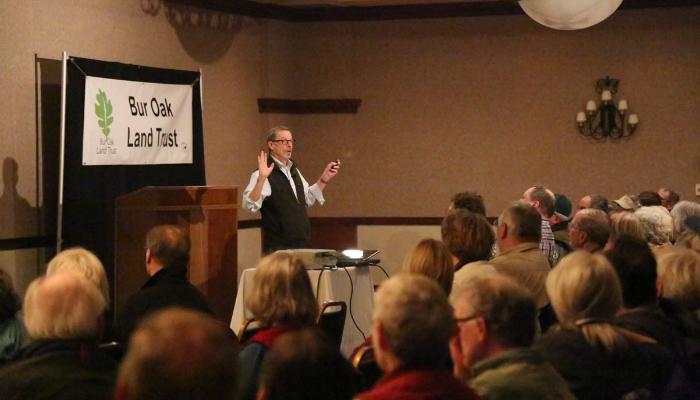Prairie Preview: Connecting and Finding Ways to Conserve

Attendance at Prairie Preview has increased every year and this year that trend seemed to continue. About 300 people came through the doors of the Clarion Highlander Hotel on North Dodge in Iowa City for Prairie Preview XXXIV on March 9. Approximately 45 exhibitors spread out in the main entryway as well as an adjacent room to share information about their projects and initiatives. Representatives ranged from local governments highlighting their commitments to natural spaces and sustainability efforts to nonprofit organizations that promote reduction in plastic bag use, the development of edible landscapes, greater exploration of outdoor experiences, and the protection of wildlife to name just a few. There was also an area where visitors could enjoy wonderful homemade refreshments provided once again by the Four Seasons Garden Club.
One observer and long-time participant in the Prairie Preview noted the number of children in attendance. That’s surely a good thing since they will be tomorrow’s stewards of our environment.
Bur Oak Land Trust Board Treasurer Dick Schwab started the evening’s program by introducing Marian Riggs of Iowa’s Water & Land Legacy (IWILL) who gave a brief update on the Natural Resources and Outdoor Recreation Trust Fund. The fund was created in 2010 but has remained empty. Surveys consistently show Iowans favor a 3/8 cent tax to support the fund, but no action has been taken by the legislature. Marian reported some bipartisan support currently exists, and she urged everyone to let their legislators know they support this small tax so the trust fund can be put to work. Could this be the year it finally happens?
The keynote speaker was Steve Hendrix, Professor Emeritus from the University of Iowa’s Department of Biology. His talk was entitled “Wild Bees of Iowa: Hidden Diversity in the Service of Conservation.” How many of us have noticed bees in our gardens but have not known what type they are? Perhaps recognizing honey bees and bumble bees are the extent of our identification skills. There is much more to learn. Hendrix and Mary Harris of Iowa State University have cataloged about 300 bee species in Iowa, and that is only from 57 of our 99 counties. They speculate the number could be as high as 400.
Hendrix says that wild bees are better pollinators. Honey bees only spend about three seconds in each flower, but diversity of species is still key. When honey bees and wild bees are together in a grove, more pollination takes place than when only one species is present.
With the devastation of colony collapse you might wonder if your small garden or wild remnant helps. Hendrix says it does; pollinator-friendly areas do not have to be large. Even small areas like railroad remnants can effectively support bees. Unlike honey bees, wild bees do not dwell in a colony. They nest solitarily in the ground or in plant stems. So here is more good news. Don’t bother clearing out the dried stems and stalks in your garden—you can just “let them bee.”
Tags: Diane DeBok, Prairie Preview, Steve Hendrix, wild bees

